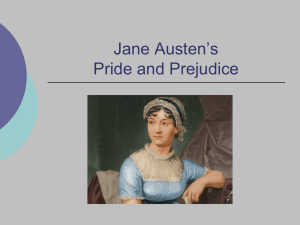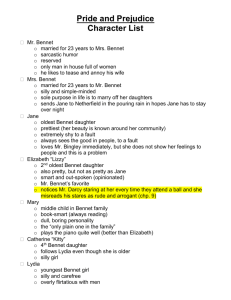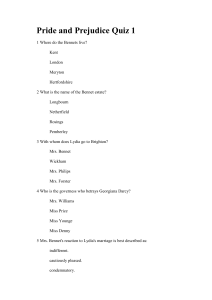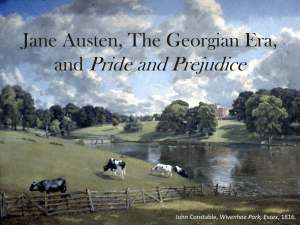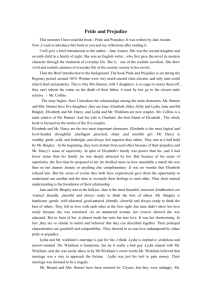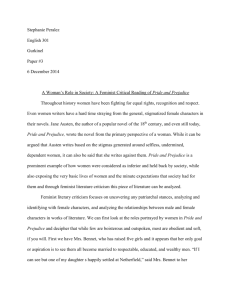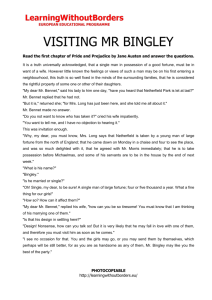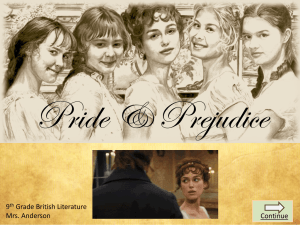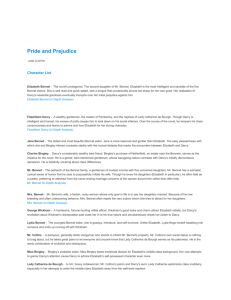Pride and Prejudice: Satire & Social Change Essay
advertisement
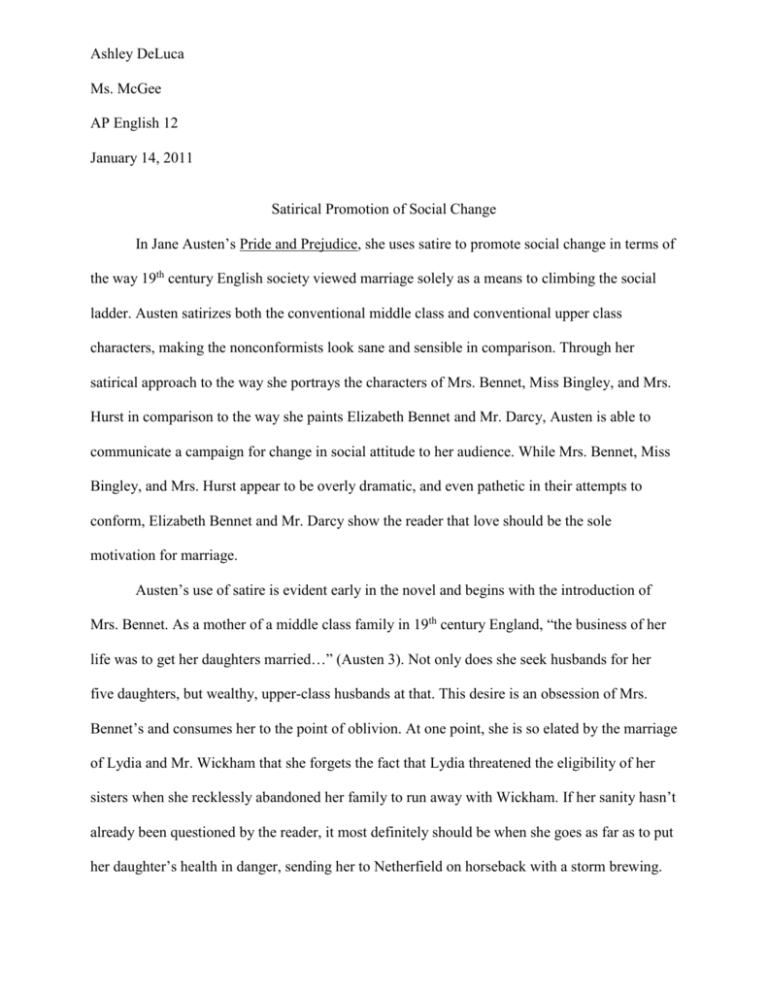
Ashley DeLuca Ms. McGee AP English 12 January 14, 2011 Satirical Promotion of Social Change In Jane Austen’s Pride and Prejudice, she uses satire to promote social change in terms of the way 19th century English society viewed marriage solely as a means to climbing the social ladder. Austen satirizes both the conventional middle class and conventional upper class characters, making the nonconformists look sane and sensible in comparison. Through her satirical approach to the way she portrays the characters of Mrs. Bennet, Miss Bingley, and Mrs. Hurst in comparison to the way she paints Elizabeth Bennet and Mr. Darcy, Austen is able to communicate a campaign for change in social attitude to her audience. While Mrs. Bennet, Miss Bingley, and Mrs. Hurst appear to be overly dramatic, and even pathetic in their attempts to conform, Elizabeth Bennet and Mr. Darcy show the reader that love should be the sole motivation for marriage. Austen’s use of satire is evident early in the novel and begins with the introduction of Mrs. Bennet. As a mother of a middle class family in 19th century England, “the business of her life was to get her daughters married…” (Austen 3). Not only does she seek husbands for her five daughters, but wealthy, upper-class husbands at that. This desire is an obsession of Mrs. Bennet’s and consumes her to the point of oblivion. At one point, she is so elated by the marriage of Lydia and Mr. Wickham that she forgets the fact that Lydia threatened the eligibility of her sisters when she recklessly abandoned her family to run away with Wickham. If her sanity hasn’t already been questioned by the reader, it most definitely should be when she goes as far as to put her daughter’s health in danger, sending her to Netherfield on horseback with a storm brewing. Ashley DeLuca Ms. McGee AP English 12 January 14, 2011 “Well, my dear if your daughter…should die, it would be a comfort to know that it was all in pursuit of Mr. Bingley, and under your order,” said Mr. Bennet after hearing of Jane’s illness (Austen 26). Mrs. Bennet is depicted as a silly, over-dramatic woman. She is not to be taken seriously by the reader and is a one of the main sources of humor in the novel, especially when foiled by her husband. “Ah! You do not know what I suffer,” said Mrs. Bennet dramatically in response to Mr. Bennet’s refusal to visit Mr. Bingley at her request (Austen 3). At the opposite end of the spectrum, Miss Bingley and Mrs. Hurst represent the conventional upper class. They are perceived by the reader to be insolent, snobbish women. It is apparent that both women disagree with the intermingling of social classes, particularly in the actions of Miss Bingley in concern to the dynamic relationship between Elizabeth Bennet and Mr. Darcy. When Jane fell ill at Netherfield and Elizabeth Bennet traveled to accompany her ailing sister, the reader finally gets to see real interaction between Elizabeth Bennet, Mr. Darcy, and Miss Bingley. While Mr. Darcy writes a letter to his sister, Miss Bingley is pathetic in her attempts to bond with him and show off her relationship with the Darcy family, but to no avail, as Mr. Darcy indirectly tells her to leave him alone. Miss Bennet is a comical character because of her delusional idea that she’s better than everyone else when the reader actually perceives her to be a pitiable character. Austen also pokes fun at conventional high society through Miss Bingley’s backhandedness in her friendship with Jane Bennet. After returning to London, Miss Bingley writes to Jane telling her all about her brother’s blossoming relationship with Mr. Darcy’s sister. “Caroline boasted joyfully of their increasing intimacy…” (Austen 115). Miss Ashley DeLuca Ms. McGee AP English 12 January 14, 2011 Bingley’s insensitivity towards her so-called friend shows that her lack of morality and heart negates her social standing and makes it difficult for the reader to take her seriously. The satirical nature of these characters makes Mr. Darcy and Elizabeth Bennet stand out in the reader’s mind as moral, level headed people. Mr. Darcy and Elizabeth overcome the social prejudices of the time; whereas, Mrs. Bennet is still pressuring her daughters to marry up and Mrs. Hurst and Miss Bingley are encouraging Mr. Darcy and Mr. Bingley not to marry beneath them. However, the reader knows better than to take the satirized characters of Mrs. Bennet, Mrs. Hurst, and Miss Bingley seriously and is won over by the love story between Mr. Darcy and Elizabeth Bennet. In this way, it is evident that the novel Pride and Prejudice advocates a change in society’s attitude towards marriage. By painting those characters who act in the socially accepted “correct manner” of the time as silly, nonsensical people, Austen gives more merit to her more rebellious characters; therefore, giving merit to their “rebellious” actions. Marrying outside one’s class for love rather than money seems acceptable when Mr. Darcy and Elizabeth Bennet do it.
